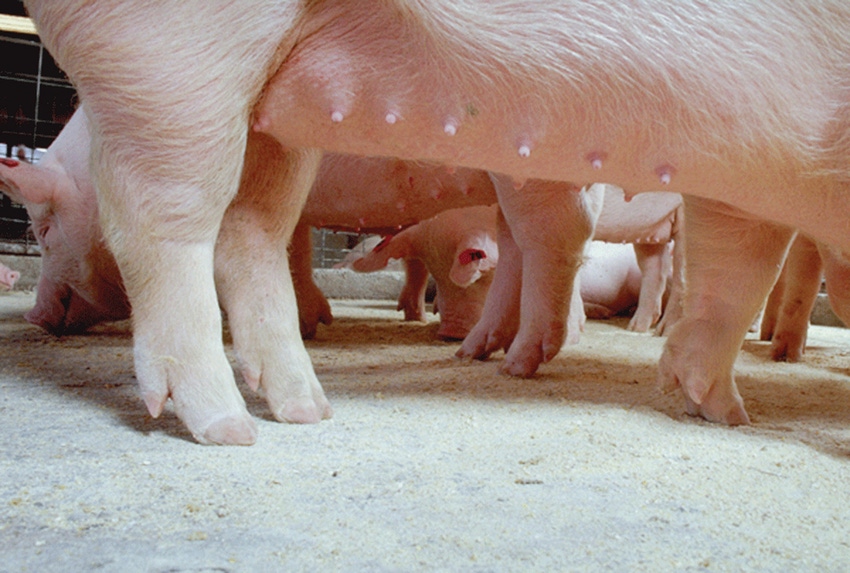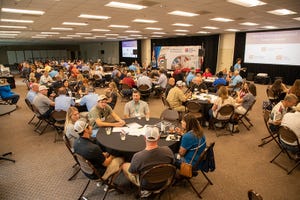Impressions of sow overgrown toes on U.S. farms
What is the prevalence and what environmental factors are driving this?
November 7, 2023

By Derek Henningsen, Anna K. Johnson, Jennifer Bundy, Marta Mainenti, Locke Karriker and K. Stalder, Iowa State University
Gilt selection based on feet structure is critical so that a robust female is successfully added into the breeding herd.
Stalder et al., (2010) identified ideal gilt feet structure as large, square and evenly spaced toes with even toe size. The sow’s foot is comprised of four individual toes, two of which are weight bearing. The remaining two toes are called dew claws and these are non-weight bearing. Selecting gilts with ideal feet will result in better length of stay, profitability, improved sow welfare and caretaker morale.
The most common issue reported on farms related to sow feet are overgrown toes and dew claws. Overgrowth occurs when the hoof horn growth exceeds the hoof horn wear. Reports on sow breeding populations indicate variable overgrown toe incidences from 4.5% to greater than 25%. The incidence rate along with the randomness of farm location, suggest that environment factors, such as flooring type, hygiene and housing type may impact toe overgrowth.
However, the relationship between environmental factors and the overgrown toe prevalence in breeding herds in the United States remains unclear. This work polled farm managers and asked them “how many sows on their farms had overgrown toes?” and for the research team to try and identify what environmental factors are involved in overgrown toes.
A 20-question Spanish and English survey was created and all survey questions were self-reported by the participants. Questions were separated into six categories: farm demographics, flooring, sow characteristics, lameness, incidence of overgrown toes and removal reason. Fifteen questions allowed participants to select the one answer that best applied. A single question allowed multiple answers to be selected. Four questions were labeled “open ended” and allowed participants the option to respond with their own answer.
Seven questions will be presented in this work. For question 2 respondents could select “all that apply.” For all other question’s respondents were asked to “select the answer that best applies.”
1. What is the percentage of overgrown sow toes on your farm?
•<5, 6 to 10, 11 to 15, >15%, Did not Answer
2. What foot issues do you most commonly see among the sows on the farm you manage?
• Hoof wall cracks, pad lesions/cracks, severely overgrown toes, uneven toes
3. What type of gestation housing type is used on your farm?
• Individual stalls or group housing
4. What type of flooring type is used in gestation?
•Solid concrete, partially slatted or fully slatted
5. What type of flooring type is used in lactation?
•Cast iron, expanded wire, tri-bar, plastic, concrete, other
6. What is the general flooring hygiene in gestation?
•Wet or dry
7. What is the most prevalent reason for observed sow lameness that occurs on the farm you manage?
•Dew claws, foot lesions, joint issues, long/overgrown toes, other
The top 20 swine producing companies were chosen as potential survey participants by utilizing the Successful Farming Exclusive: Top 40 U.S. Pork Powerhouse List of 2020. Surveys were sent to sow farm managers. All responses were entered anonymously, with no traceability back to the sow farm, manager or production company. The survey was open for 72-d and surveys were considered “complete” if greater than 80% of the questions were answered. A total of 63 surveys (that encompassed 275,000 gilts and sows) were completed.
Half of the participants ranked the prevalence as low (≤5%) and only 6% of respondents reported overgrown toe percentages greater than 15% (Figure 1). Sow farm managers identified pad lesions/cracks as the number one-foot issue seen on-farm with overgrown toes second (Figure 2).
ISU
ISU
There were no observed relationships between housing type, flooring type, or flooring condition and the percentage of overgrown toes, but there was a significant correlation between lameness reason and percentage of overgrown toes (Table 1).
ISU
Nine farms reported “dew claw problems” as their primary lameness reason. Twenty participants reported “foot lesions” as their primary lameness reason. Twenty-one farm managers reported “joint issues” as their primary lameness reason. Eight contributors reported “overgrown toes” as their primary lameness reason. Three respondents reported “other” as their primary lameness reason.
Summary points:
Majority of farm managers reported extremely low instances of overgrown toes on their farms.
This study provided no evidence that housing type, flooring type or flooring condition contributed to increased instances of overgrown toes.
The majority of farm managers reported foot lesions as their primary lameness reason.
You May Also Like



